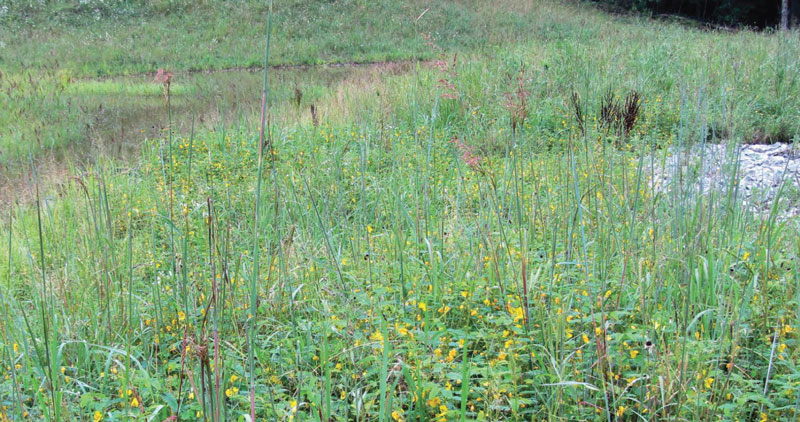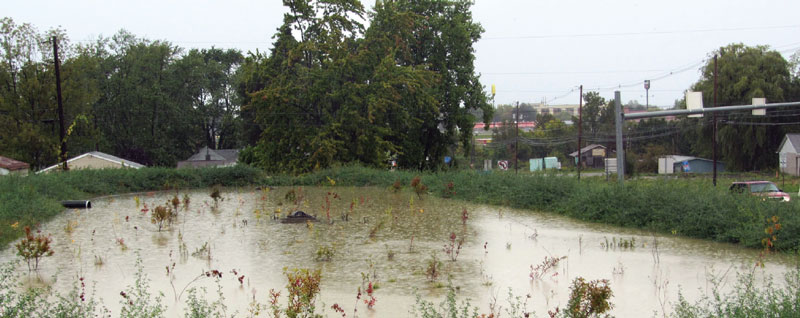Mature rain garden at the Crawford County Fairgrounds in Meadville, Pennsylvania using ERNMX-180 Rain Garden Mix.
The sites (i.e., size, location and depth) must be designed and constructed according to all applicable ordinances and under the direction of a qualified design professional.
In addition to planting trees and shrubs, seeding with native plant species is an economical way of vegetating stormwater management sites. Erosion control fabric, mulch or hydro mulch is necessary to control erosion both during and after construction.
Examples include bioswales (vegetated trenches that convey stormwater away while reducing velocity and volume, and promoting infiltration of water into the ground); detention basins (temporarily impounds run-off water, allowing for release at controlled rates); retention basins (stormwater management facilities with permanent impoundment or pool for improving water quality) or bioretention basins and rain gardens (dynamic, living microbiological systems that enhance retention, infiltration and evaporation of run-off water while remaining attractive to wildlife).
In all stormwater management facilities, plants prevent erosion and slow water movement, hold or convert pollutants, enhance infiltration and evapotranspiration, and encourage wildlife. Plant species or mixes may be selected that meet critical objectives and extreme conditions of the site. Native grasses produce fibrous root systems that tolerate fast-moving water. Woody and herbaceous species add aesthetics, provide wildlife food and habitat, and assist with evapotranspiration while preventing erosion.
To avoid stand failure, select a seed mix appropriate for the site’s hydrology (moisture status). If the site is chronically moist with long periods of inundation, a retention basin, FACW meadow, or OBL wetland mix is appropriate; if chronically moist with occasional inundation (immediately after a rainfall) and periodic drying out, a FACW meadow or riparian floodplain mix is appropriate; or, if typically dry except for a 12-72 hour period after a rainfall, a detention basin or rain garden mix is appropriate.
Prior to planting the site, invasive species, particularly those adapted to wet conditions, should be removed or sprayed using an approved herbicide by a licensed spray technician. Perennial weeds not addressed before establishment will be difficult to remove later. Normal vegetation can be worked into the topsoil which should be stockpiled until the final grade has been established.

With specifications and dimensions, on-site construction of the berm and outlets must be executed carefully to maintain structural integrity. The infiltration and plant growth areas should be loose and friable (easy to crumble), high in organic matter, and completed without compaction by heavy equipment. An excavator may be used to dig and drop each area of the bottom soil in a loose manner. Lime or compost can then be incorporated. The excavation machine does not move over the finished surface thereby avoiding unnecessary compaction. Native vegetation can be planted or seeded over this uneven absorbent surface.
Seeding and planting should begin immediately upon completion of the structure while the soil is still friable and before weeds emerge. Plan seeding and planting before the basin is flooded or allow the basin to drain before seeding. Broadcast seed evenly over each unit by hand seeding or hydroseeding. Seeding rates are generally low (1/2 lb per 1,000 sq ft). If broadcasting seed, see Seeding Methods on p. . If the soil is dry, incorporate the seed into the soil with a garden rake. Oats or rye can provide temporary vegetation to protect the soil until permanent vegetation is established. Using such native species as Elymus virginicus (Virginia Wildrye) can create an intermediate cover that is succeeded by long-term native vegetation. Straw mulch or straw coconut mats are frequently used to control erosion and protect emerging seedlings from extreme temperatures and drying out. Mulch should be sparse to allow sunlight to reach the ground. If the site is a retention basin, refer to the Wet Meadow & Wetland Sites Establishment Guide.
Transplanted seedlings and shrubs may need to be watered until they become well-rooted. Irrigating seeded areas is beneficial until seedlings become established.
Whenever canopy height (overall vegetation) reaches 18”-24”, use a brush hog mower or string trimmer to trim the meadow to 8”. Trimming reduces competition by fast-growing weeds for sunlight, water, and nutrients needed by slower growing perennial natives. A lawn mower is not recommended as the mower height will be too low and native seedlings will be killed.
If bioengineering or containerized woody materials were used on the site or seed of shrubs/trees were part of the mix, the site should not be trimmed after the establishment year.
Problem weeds should be hand pulled or spot sprayed with an approved herbicide, such as Rodeo®, Garlon® 3A, or Milestone® (do not use Milestone® where standing water is present). Be vigilant in controlling vines or spiny plants if they were not part of the mix. These are more easily pulled early than after they have had two to three months of growth. Examples include bindweed, blackberry, multiflora rose, mile-a-minute, and Japanese hops. Be equally vigilant in the control of other invasive species, such as autumn olive and Japanese knotweed.

Prior to new spring growth reaching 2” (e.g., shortly after forsythia or redbud blooms), trim any material standing from the previous year close to the ground (approximately 2”). If the seed mix included sedges, trimming should be no lower than 2” above the crowns that produced the prior year’s growth. This will allow the soil to warm more quickly, stimulating emergence and growth of native plants and reducing the likelihood of shrub invasion.
If bioengineering or containerized woody materials were used on the site or seed of shrubs/trees were part of the mix, the site should not be trimmed after the establishment year.
Problem weeds should be hand pulled or spot sprayed with an approved herbicide, such as Rodeo®, Garlon® 3A, or Milestone®. Be vigiliant in controlling vines or spiny plants if they were not part of the mix. These are more easily pulled early than after two to three months of growth. Examples include bindweed, blackberry, multiflora rose, mile-a-minute, and Japanese hops. Be equally vigilant in the control of other invasive species, such as autumn olive and Japanese knotweed.
If there is a heavy infestation of ragweed or foxtail in the second growing season, trim the meadow to 8”. If bioengineering or containerized woody materials were used, trimming should be above or around new growth of the plants. Trimming should cease after mid-September.
In addition to structural maintenance, siltation should be removed as needed. Close mowing throughout the growing season or extensive chemical use is not conducive to water quality improvement and wildlife habitat.
Find more seeds and seed mixes like these using the advanced search and filtering options of our Seed Finder Tool.
DISCLAIMER: The information in this review of practices is the result of more than 50 years of experience in seed production. Ernst Conservation Seeds has been supplying seeds and consulting in the reseeding of tens of thousands of acres of roadsides, surface mined lands, conservation, and restoration sites in eastern North America, as well as growing and supplying seed and consulting in the planting of hundreds of thousands of acres of CRP/CREP-related areas for erosion control and wildlife habitat. All of these practices are opinion only and our best advice as a result of these experiences. These recommendations do not cover all the conditions that will be encountered in the field. All of the information is for individual consideration. Ernst Conservation Seeds is not responsible for conditions that will be encountered in individual situations. The use of brand names does not represent our endorsement of a specific product; rather, it represents our experience only and has not necessarily been replicated in peer-reviewed research. The use of chemical pest control agents is subject to manufacturers’ instructions and labeling, as well as federal, state, and local regulations.